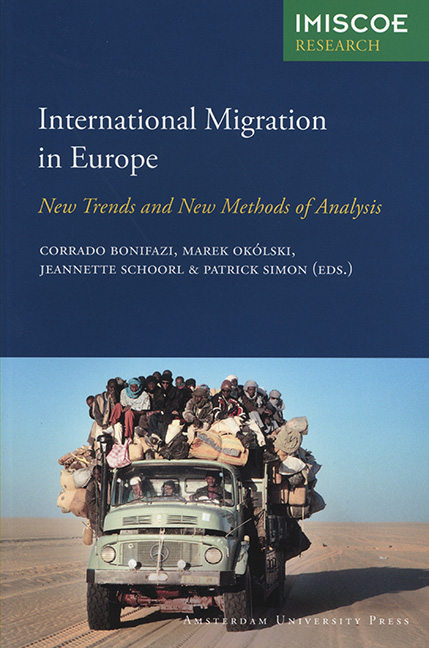Book contents
- Frontmatter
- Contents
- Preface
- 1 Introduction
- PART I NEW FORMS OF MIGRATION IN EUROPE
- PART II EVOLUTION OF REGIONAL PATTERNS OF INTERNATIONAL MIGRATION IN EUROPE
- PART III MEASURING INTEGRATION: IMMIGRANTS AND THE SECOND GENERATION
- PART IV SPECIAL SURVEYS IN INTERNATIONAL MIGRATION STUDIES
- List of Contributors
- Index
- Other IMISCOE Titles
13 - One-Way or Both-Ways Migration Surveys
Published online by Cambridge University Press: 22 June 2021
- Frontmatter
- Contents
- Preface
- 1 Introduction
- PART I NEW FORMS OF MIGRATION IN EUROPE
- PART II EVOLUTION OF REGIONAL PATTERNS OF INTERNATIONAL MIGRATION IN EUROPE
- PART III MEASURING INTEGRATION: IMMIGRANTS AND THE SECOND GENERATION
- PART IV SPECIAL SURVEYS IN INTERNATIONAL MIGRATION STUDIES
- List of Contributors
- Index
- Other IMISCOE Titles
Summary
In the nineteenth century, demography started by studying registered events: births and deaths. Migration, as a move, is an event that involves two places. Statistics for this type of event did not become available until much later. In fact we had to wait for modern censuses to record people according to places: first the place where they resided, later the place where they were born, and more recently a place where they resided some time ago – usually five years before a census. Population registers also record people according to places where they live and have lived in the past. These data are at the origin of the modern study of migration, as a part of demography.
At first, migration was only considered as a factor of bias in mortality and fertility estimates. The study of migration as a demographic phenomenon in itself has developed more recently for methodological reasons. Migration is a repeatable event and, unlike other repeatable events such as births, it takes various forms – forward, backward, circular – and has various types when geographical boundaries are considered – moves within or between geographical units – and can be called internal or external. Data on moves between countries (international migration) only recently became available and are still the poorest. Therefore, the study of migration started with internal migration data from censuses and population registers and later from specific surveys. As a repeatable event varying in its form and types, migration is best described as a succession of events or a process (Massey 1987): short distance moves often precede long distance moves; migration also often follows family events, like marriage. Thus, the study of migration developed more rapidly when progress was made in the analysis of biographies collected by surveys (Courgeau 1989, 1990; Courgeau & Lelievre 1992; Findley 1982; Goldstein & Goldstein 1981; Massey 1993) or from population registers (Baccaini & Courgeau 1996).
The study of internal migration has already reached a very high technical and theoretical level but international migration lags behind, due to poor quality data and a scarcity of surveys providing results that can be generalised.
- Type
- Chapter
- Information
- International Migration in EuropeNew Trends and New Methods of Analysis, pp. 273 - 292Publisher: Amsterdam University PressPrint publication year: 2008
- 5
- Cited by

